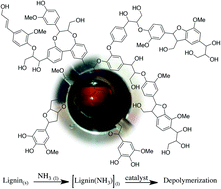The separation of lignocellulosic biomass into its three component polymers; cellulose, hemicellulose, and lignin, is an important field of research relevant to biorefineries and the production of bio-based products. The chemical valorisation of polysaccaharides (to bio-ethanol for example) and the paper industries leave the lignin behind as waste.
Rich in aromatic functionality, it is unfortunate that because of the poor solubility of lignin up to 40% of lignocellulosic biomass feedstock is consigned to low value applications.
The use of ammonia as a solvent for lignin has now been revisited by a team of Dutch scientists in order to resolve this solubilisation bottleneck. Ammonia was shown to readily dissolve most varieties of lignin at room temperature and 7-11 bar, and can be removed simply by releasing the pressure.
The mild conditions make ammonia an attractive solvent for biorefineries looking to maximise lignocellulosic biomass utilisation. Furthermore the necessary apparatus is already incorporated into biorefineries for the ammonia fibre explosion (AFEX) process.
This article is open access and available to everyone to read for free:
Lignin solubilisation and gentle fractionation in liquid ammonia
Zea Strassberger, Pepijn Prinsen, Frits van der Klis, Daan S. van Es, Stefania Tanasea and Gadi Rothenberg
Green Chem., 2014, Advance Article. DOI: 10.1039/C4GC01143K











